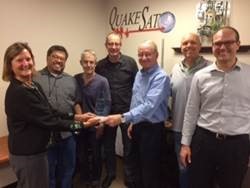QuakeFinder is awarded the 2015 VIA SAT Humanitarian Excellence Award
QuakeFinder was awarded the VIA SAT Humanitarian Excellence Award for 2015 at the recent Satellite 2015 Conference in Washington DC.
The award is given to a company or group that uses satellites to promote the welfare of mankind.
In this case QuakeFinder uses both ground (QuakeFinder 165 site Magnetometer network) and space( the GOES weather satellite’s IR camera) to develop a system to forecast large earthquakes days before they happen. This research is ongoing and is refining a system to detect these devastating earthquakes, and ultimately to save lives. Congratulations to the QuakeFinder Team (below)





 Example 2 During the solar storm where a large signal is observed at a location where there is a known salt water submerged lake (Parkfield):
Yellow and red bars show the level of a large magnetic storm (Magnetic index Kp from NOAA Space Weather website).
Example 2 During the solar storm where a large signal is observed at a location where there is a known salt water submerged lake (Parkfield):
Yellow and red bars show the level of a large magnetic storm (Magnetic index Kp from NOAA Space Weather website).
 .
These same signals are observed at all our magnetometer sites, but some are lower than others due to ground conductivity.
Example 3 During the solar storm but where a smaller signal is observed at a site in a dry mountainous area:
.
These same signals are observed at all our magnetometer sites, but some are lower than others due to ground conductivity.
Example 3 During the solar storm but where a smaller signal is observed at a site in a dry mountainous area:
